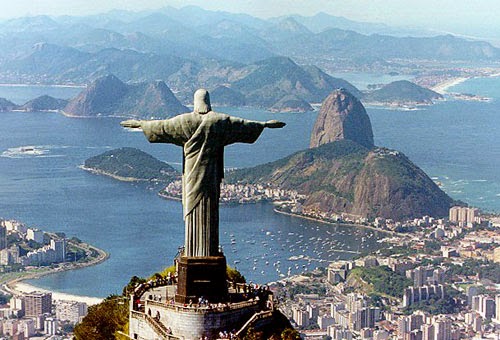 |
| Rio de Janeiro, Brazil during the daytime http://travel.nationalgeographic.com/travel/countries/brazil-photos/ |
Final Blog- The Present and Future of Rio: (Geography Wise)
Rio de Janeiro, Brazil is considered a costal landscape, and it has it's own unique way of identifying itself and having millions of people visit this destination and have it as a world hotspot. It is surrounded by both water (ocean) and mountains. It is unique for a location to have both luxuries of having two different types of geographical features so, its a one and only. Metamorphosed Granite type of rock is most common and popular in Rio. And over the years it has been changing it's shape and sizes due to heat, pressure and friction. Rio has many mountain hillsides that are the Sugarloaf Dome rocks. These type of rocks are the signature of rio, and it's what the mountain side of Rio consist off. The tropical hot temperatures of Rio can cause a chemical weathering of the rocks. The sugarloaf domes caused by exfoliation sheets. Help the weather/climate also maintain it's rainforest status. Rio is considered to be in the rainforest/savannah climate type also. But because of costal location, Weather is hot, humid and dry in the winter months, and wet in the summer months where rain and precipitation are on the rise. The wetness on the clay soil causes landslides along with the Serra do Mar costal range on the Brazilian side of South America. Intense wet weather also happens a lot in rio because its on the Atlantic Ocean side (Hurricane, Monsoons)
Hypothesis- Landscape of Rio: In (10,000) (1,000,000) (100,000,000) Years
LANDSCAPE: (10,000) YEARS
My hypothesis for what the future landscape of Rio might look like in 10,000 years is very close or even similar of what Rio looks like today. I truly believe that there will be changes in the landscape and that the rock formation will continue to change and decay, but it will do so very slowly. It will take years for drastic change to start happening. The hot humid weather in Rio will continue to expand rock, making more Sugarloaf domes and expanding the style of rocks into other areas. The weather shall remain the same because it is part of the climate Rio. It's unique location makes it hard for the weather to detour in a different direction.
LANDSCAPE: (1,000,000) YEARS
Because Rio is a Costal location, and due to the rise of global warming and water rising and lowering and everything changing in the costal areas. I predict that now is when the landscape starts to change. the deteriorating and expanding of the rock decay, could possibly hurt the tropical rainforest in the surrounding areas of the outsides of the city. The rainforest/savannah will start to disappear due to the changes that global warming brings. A growth in population and pollution could play a factor to possibly Rio becoming a smaller city, because the geography will start to change the city. In class the other day we looked at a picture map of Florida and where it's costal lines are now. Global warming will change the future and its costal boarders will be gone, and Florida will be more inland and smaller. Miami would be gone. I'm thinking, could the same thing occur in Rio after 1,000,000 years of a changed landscape.LANDSCAPE: (100,000,000) YEARS
My prediction of Rio, after 100,000,000 years is that it will possibly be smaller and not as beuatiful as it is today. The climate and geographical features will have changed. The coast will not be where it is today. Rio will be more inland or possibly not be on the map in the same location. Weather, climate, global warming will have the rainforest eliminated or possibly in danger. Rio will be different and changed in 100,000,000 years because the way the earth is going, drastic changes will be made around the world. Changing the geographical landscape of many locations around the globe. Including Rio de Janiero, Brazil.
Conclusion: Rio de Janiero will change in the future. climate change, rock decay, global warming and more will all fall into place and bring changes to this specific location. Change will probably not happen for the first years, it will look the same as it does now. But it will slowly change. Maybe for the better or worse, I don't really know. But rio will be changed for sure. And it will look different than what it looks like today. That is the same with any other location in the globe. It's just a matter of time before that happens. But it will. So believe that, It will. It will be a new Rio de Janeiro, in the heart of Brazil. South America.
References:
www.rentanapartmentinrio.com/arpoadordiabobeach.html
www.exploringthearth.com/2013/01/12/rise-in-rio/
Class Lecture: earths innards
duff.ess.washington.edu/grg/publications/pdfs/fernandes_et_al.pdf
https:www.scribd.com/mobile/doc/141800150
Class Lectures: Volcanic Forms, Mass Wasting & Infiltration, Soils
Reference: (Class Lecture): Earth's Temperatures
Reference: http://www.riodejaneiro.com/blog/2012/10/22/rio-de-janeiro-climate/
Reference: http://www.unique-southamerica-travel-experience.com/climate-of-brazil.html











